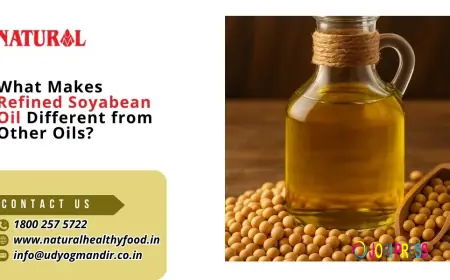Thiochemicals Market Size, Share, and Growth Trends in 2030
Thiochemicals Market Size, Share, and Growth Trends in 2030
Introduction
The Thiochemicals Market is experiencing steady growth driven by the increasing adoption of thiochemical-based solutions across various industrial verticals including animal nutrition, oil & gas, agrochemicals, and specialty polymers. Valued at USD 1.10 billion in 2024, the market is projected to grow at a CAGR of 4.45% through 2030, as per TechSci Research. With applications ranging from hydrodesulfurization in fuels to amino acid synthesis for animal feed, thiochemicals are integral to environmental compliance and industrial productivity.
Industry Key Features
1. Versatile Applications
Thiochemicals are used extensively across several industries:
-
Oil & Gas Industry: For catalyst protection, sulfur removal, and gas odorization.
-
Animal Feed: In the form of methyl mercaptan to synthesize DL-methionine.
-
Agrochemicals: As a substitute for methyl bromide in soil fumigation.
-
Polymers & Specialty Chemicals: As chain transfer agents and intermediates.
2. Regulatory Support
Increasing global emphasis on low sulfur fuels and environmentally compliant agricultural practices is bolstering demand. Government policies across Europe, India (Bharat Stage VI), and China (China VI) are pressuring refiners and chemical manufacturers to adopt low-emission, efficient additives—many of which are thiochemical-based.
3. Technological Integration
Advanced thiochemical processes are being implemented to improve:
-
Refinery performance
-
Fertilizer efficiency
-
Polymer integrity
-
Odor management in natural gas
These technological innovations are supporting sustainable development goals while ensuring industrial cost-efficiency.
Segmental Analysis: Ingredient Insights
Animal Nutrition: The Dominant Segment
In 2024, animal nutrition emerged as the leading application segment in the global thiochemicals market. A crucial driver of this segment is the production of DL-methionine using methyl mercaptan, which significantly improves feed conversion efficiency in poultry and livestock.
The global shift toward high-protein diets and the industrialization of meat production in regions like Asia Pacific, Latin America, and the Middle East is contributing to this upward trend. Countries such as China, India, Brazil, and Indonesia are prioritizing fortified animal feed, making methionine—and therefore thiochemicals—indispensable.
Oil and Gas Industry: A Backbone for Growth
The oil & gas sector continues to be a substantial consumer of thiochemicals. Dimethyl disulfide (DMDS) is employed in hydrodesulfurization (HDS) units to protect catalysts and ensure efficiency during fuel refining. As more countries push for ultra-low sulfur fuels, thiochemical integration in refineries becomes mandatory.
The growth of shale oil exploration in North America and refinery expansion in the Middle East and Asia-Pacific are driving demand for these specialized chemical agents.
Agrochemicals: Sustainable Alternatives Rising
Thiochemicals are progressively replacing methyl bromide, a harmful fumigant phased out under international environmental agreements. Substitutes like DMDS and thiourea provide effective pest and weed control with lower environmental footprints, aligning with modern sustainable farming practices.
Specialty Polymers and Chemicals
The application of thiochemicals in specialty polymers, including PVC and rubber, helps enhance product performance. Thioglycolic acid, for instance, improves polymer resilience, and its derivatives are increasingly employed in cosmetic formulations and adhesives.
Emerging Trends and Market Drivers
1. Transition Toward Green Chemistry
One of the most significant trends is the transition to environmentally friendly alternatives. Thiochemicals serve as eco-compatible replacements for traditionally hazardous chemicals used in agriculture, gas processing, and manufacturing.
2. Methionine Demand from Poultry Industry
The expanding poultry sector, especially in India, China, and Brazil, continues to push methionine usage. As a sulfur-containing essential amino acid, methionine supports faster weight gain, better egg production, and improved immunity in poultry, underpinning rising thiochemical demand.
3. Growth of Shale Gas and LNG Infrastructure
With the LNG and shale gas sectors expanding rapidly in the U.S., Canada, and China, thiochemicals such as mercaptans and DMDS are being increasingly used in gas processing and odorization, further stimulating market expansion.
4. Shift Toward Sustainable Crop Protection
Stringent pesticide regulations have forced agrochemical companies to look toward biodegradable and less toxic fumigants. This has created a niche opportunity for thiochemical-based fumigants and herbicide precursors.
5. Expansion of Polymer and Chemical Industries in Asia
Countries like India, Vietnam, and Thailand are ramping up investment in polymer and specialty chemical industries, providing new avenues for thiochemical application in stabilizers, catalysts, and surfactants.
Future Outlook
The Thiochemicals Market is poised for solid and sustained expansion. With continuous R&D in sulfur chemistry and increasing diversification of application verticals, the market is likely to surpass USD 1.5 billion by 2030. The development of bio-based thiochemicals, localization of production in developing countries, and digital transformation in supply chain logistics are set to redefine market dynamics.
Despite challenges such as raw material price volatility and regulatory hurdles in transportation, the market's resilience lies in its multi-sector demand base and innovation-friendly ecosystem.
10 Profit Points of Research Report
-
Comprehensive Market Size: Offers quantitative analysis of the global thiochemicals market from 2020–2030.
-
Segmentation Insights: Covers all key application areas such as animal nutrition, oil & gas, agrochemicals, and polymers.
-
Competitive Landscape: Profiles of leading players with SWOT, market share, and product strategies.
-
Emerging Trends Forecasting: Details innovation trends such as green thiochemicals and bio-based derivatives.
-
Policy and Regulatory Impact: Analyzes the effect of global environmental standards on thiochemical demand.
-
Regional Forecasting: Covers detailed country-level growth projections across North America, Asia Pacific, Europe, and MEA.
-
Demand-Supply Chain Analysis: Includes insights on feedstock trends, procurement strategies, and price dynamics.
-
Investment Attractiveness Index: Assists in identifying the most promising segments and regions for investment.
-
Technology Benchmarking: Tracks the adoption of innovative processing technologies and sustainable alternatives.
-
Customized Insights: Offers up to 10% free customization for specific business requirements.
Competitive Analysis
Major Players in the Global Thiochemicals Market:
-
Arkema: The leading manufacturer and global innovator in sulfur-based molecules, especially DMDS and mercaptans.
-
Chevron Phillips Chemical Co. LLC: Strong presence in North American gas treatment and specialty chemical sectors.
-
BASF SE: Supplies diversified thiochemical derivatives with applications in pharmaceuticals, polymers, and crop protection.
-
Bruno Bock GmbH: Specializes in niche thiochemical formulations for cosmetics, industrial chemicals, and resins.
-
Daicel Corporation: Focuses on sustainable thiochemical solutions in electronics and medical sectors.
-
Dr. Spiess Chemische Fabrik GmbH: Provides specialized thioglycolic acid derivatives.
-
Tokyo Chemical Industry (India) Pvt. Ltd.: Prominent supplier of laboratory-grade thiochemicals in the Asia Pacific.
-
TORAY FINE CHEMICALS CO., LTD.: Innovates across thiochemical applications in resins, coatings, and agro-inputs.
-
Merck KGaA: Offers pharmaceutical-grade thiourea and chemical reagents.
-
Huhhot Guangxin Chemical Trade Co., Ltd.: One of China's leading thiochemical exporters.
These players are investing in sustainable production, capacity expansion, and strategic partnerships to strengthen global supply chains and meet rising customer demand.
Contact
TechSci Research LLC
Office Address: 420 Lexington Avenue, Suite 300
New York, NY 10170, United States
Get in Touch:
Phone: +1-332-258-6602
Email: [email protected]
Website: www.techsciresearch.com
✅ Frequently Asked Questions (FAQs)
1. What are thiochemicals, and why are they important?
Thiochemicals are sulfur-based chemical compounds widely used in industries such as oil & gas, animal nutrition, agrochemicals, and specialty chemicals. They play a crucial role in hydrodesulfurization, odorization, and methionine production for animal feed.
2. Which industries drive the highest demand in the Thiochemicals Market?
The Thiochemicals Market is primarily driven by the oil & gas sector, followed by agriculture, animal feed production, polymers, and chemical manufacturing. Thiochemicals are critical in reducing sulfur content in fuels and enhancing feed efficiency in livestock.
3. What role does methionine play in the animal nutrition industry?
Methionine, synthesized using methyl mercaptan, is an essential amino acid in poultry and livestock nutrition. It improves weight gain, egg production, and feed conversion efficiency. As demand for protein-rich diets grows, the application of thiochemicals in animal feed continues to rise.
4. How are thiochemicals used in fuel desulfurization?
In the fuel refining sector, compounds like dimethyl disulfide (DMDS) are used in hydrodesulfurization (HDS) to protect catalysts and reduce sulfur emissions. This aligns with stringent fuel quality regulations such as Euro 6, Bharat Stage VI, and China VI standards.
5. Why is the Thiochemicals Market growing in India?
The thiochemicals industry in India is witnessing robust growth due to the expansion of the petrochemical sector, rising demand for low-sulfur fuels, and increased consumption of animal-based protein. Supportive government regulations are also driving the market upward.
What's Your Reaction?
 Like
0
Like
0
 Dislike
0
Dislike
0
 Love
0
Love
0
 Funny
0
Funny
0
 Angry
0
Angry
0
 Sad
0
Sad
0
 Wow
0
Wow
0


















































